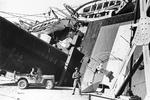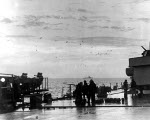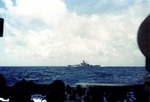
French Morocco
| Full Name | 56 French Protectorate in Morocco | |
| Alliance | Neutral or Non-Belligerent | |
| Possessing Power | France | |
| Entry into WW2 | 3 Sep 1939 | |
| Population in 1939 | 6,000,000 |
Contributor: C. Peter Chen
ww2dbaseIn 1911, a rebellion broke out against the Sultan of Morocco. Under the pretext of the protection of Europeans in the region, France dispatched troops to Fez in Apr 1911. Unable to drive out the invaders, Sultan Abdelhafid signed the Treaty of Fez on 30 Mar 1912, which established the French Protectorate in Morocco (Protectorat français au Maroc). Between 1912 and 1935, French Morocco had one of the largest 600-millimeter gauge rail networks in Africa (with more than 1,700 kilometers in total length). The original colonial capital in Fez was moved to Rabat during the Rif rebellion of the 1920s to safeguard the French administration. In the early stages of WW2, French Morocco saw some action as British and French forces clashed. In Jul 1940, British torpedo boats attacked French battleship Jean Bart at Casablanca. In Sep 1940, French bombers based in Morocco and neighboring Algeria attacked British targets in Gibraltar in retaliation of a British naval action against the French at Dakar, French West Africa. However, it was not until Nov 1942 when Morocco became involved in major fighting when US forces attacked Casablanca and the surroundings as a part of Operation Torch; the naval battle was significant in which about 180 Americans and 500 French were killed, but the fighting on land was limited. Within weeks, US President Franklin Roosevelt and British Prime Minister Winston Churchill arrived at Casablanca for the Symbol Conference, during which the demand for a German unconditional surrender was first announced. Some of Morocco's ports became logistical centers for the Allied campaigns in Italy and southern France. A number of Moroccans fought in Europe with Free French units. While the world powers struggled in the war, some of the local nationalist groups joined forces to fight the colonial administration. In Jan 1944, the Istiqlal Party, with support from Sultan Mohammed V, released a manifesto demanding full independence from France and Spain (which also occupied parts of Morocco), but the French refused to entertain any discussion. After the war, the French continued to hold French Morocco. In Aug 1953, the French thought Sultan Mohammed V was becoming revered by too many nationalist groups and forced him to abdicate, exiling him to Madagascar in Jan 1954. Mohammed Ben Aarafa, a distant relative, was installed as the new sultan. The Moroccans thought Mohammed Ben Aarafa was merely a puppet of the French, and this succession triggered even greater opposition. Mohammed Ben Aarafa was forced to abdicate in Oct 1955. In the following month, Mohammed V returned to Morocco. Seeing that they were beginning to lose control of the situation, the French abolished the protectorate in 1956. During the negotiations, Mohammed V agreed to a French request for the country to be reformed as a constitutional monarchy; the new kingdom was declared in Aug 1957 with Mohammed V as the first king.
ww2dbaseSource: Wikipedia
Last Major Update: Jan 2015
| Events Taken Place in French Morocco | ||
| British Attacks on the French Fleet | 3 Jul 1940 - 25 Sep 1940 | |
| Operation Torch | 8 Nov 1942 - 16 Nov 1942 | |
| Casablanca Conference | 14 Jan 1943 | |
Weather
WW2-Era Weather Data for French Morocco
Photographs
 |  |  |  |
French Morocco in World War II Interactive Map
Did you enjoy this article or find this article helpful? If so, please consider supporting us on Patreon. Even $1 per month will go a long way! Thank you. Share this article with your friends: Stay updated with WW2DB: |
Visitor Submitted Comments
4 Nov 2019 09:44:42 AM
Have found letters to American Soldier from a French woman, Yvonne ?. They had met when he was in Casablanca in WWII. No last name for her and the letters had no envelope with them. One name she mentioned in the letter was Bernard. Yvonne would likely be over 100 years old and deceased. Wondering if anyone would have any clues? A long shot for sure. Thanks
All visitor submitted comments are opinions of those making the submissions and do not reflect views of WW2DB.
- » WW2DB's 20th Anniversary (29 Dec 2024)
- » Wreck of USS Edsall Found (14 Nov 2024)
- » Autumn 2024 Fundraiser (7 Nov 2024)
- » Nobel Peace Prize for the Atomic Bomb Survivors Organization (11 Oct 2024)
- » See all news
 |
- » 1,150 biographies
- » 337 events
- » 44,024 timeline entries
- » 1,242 ships
- » 350 aircraft models
- » 207 vehicle models
- » 375 weapon models
- » 123 historical documents
- » 260 facilities
- » 470 book reviews
- » 28,587 photos
- » 432 maps
Winston Churchill
Please consider supporting us on Patreon. Even $1 a month will go a long way. Thank you!
Or, please support us by purchasing some WW2DB merchandise at TeeSpring, Thank you!
12 Apr 2018 08:50:39 PM
Just saw a show, where US troops were fight The ZFrench during WWII...any info on this???